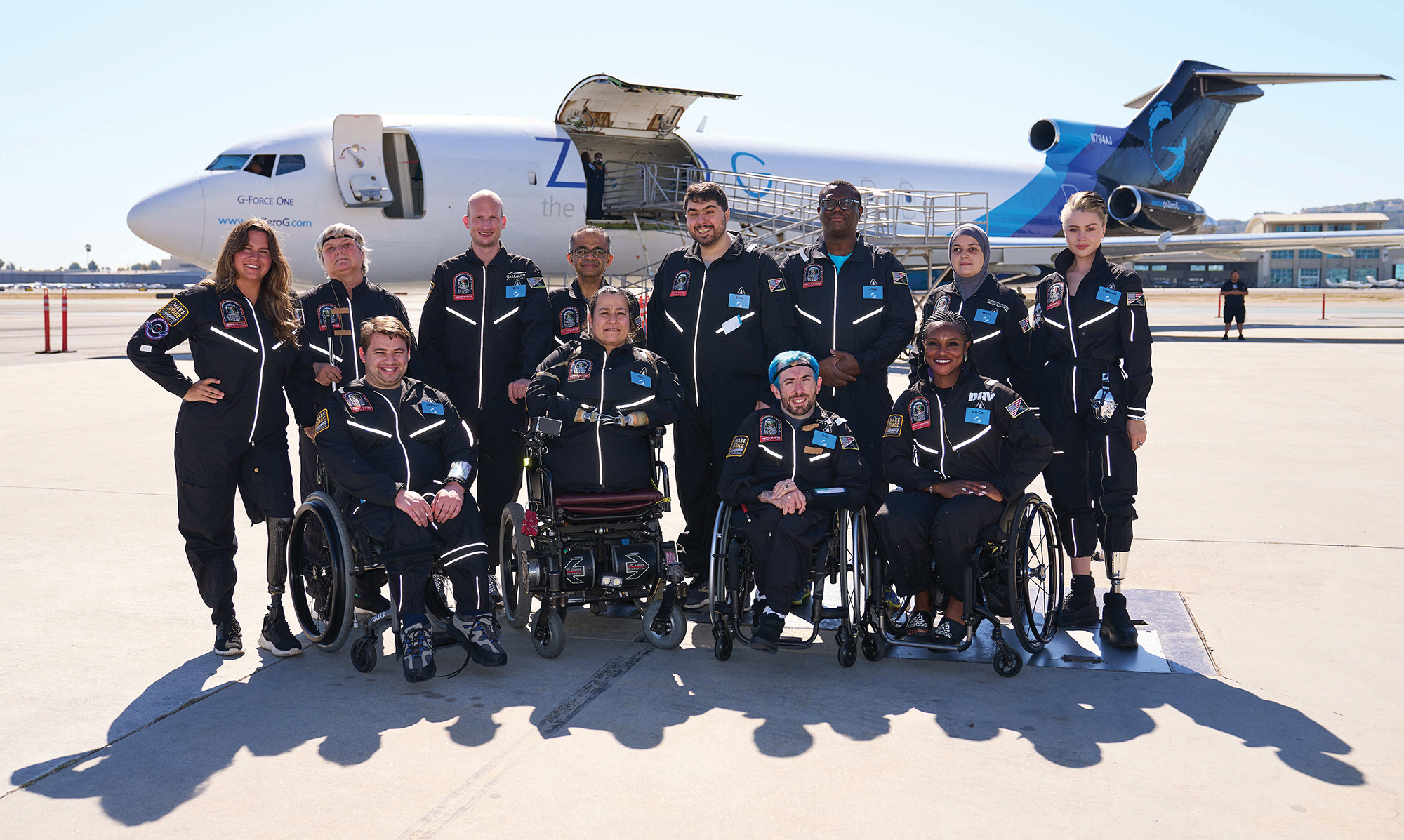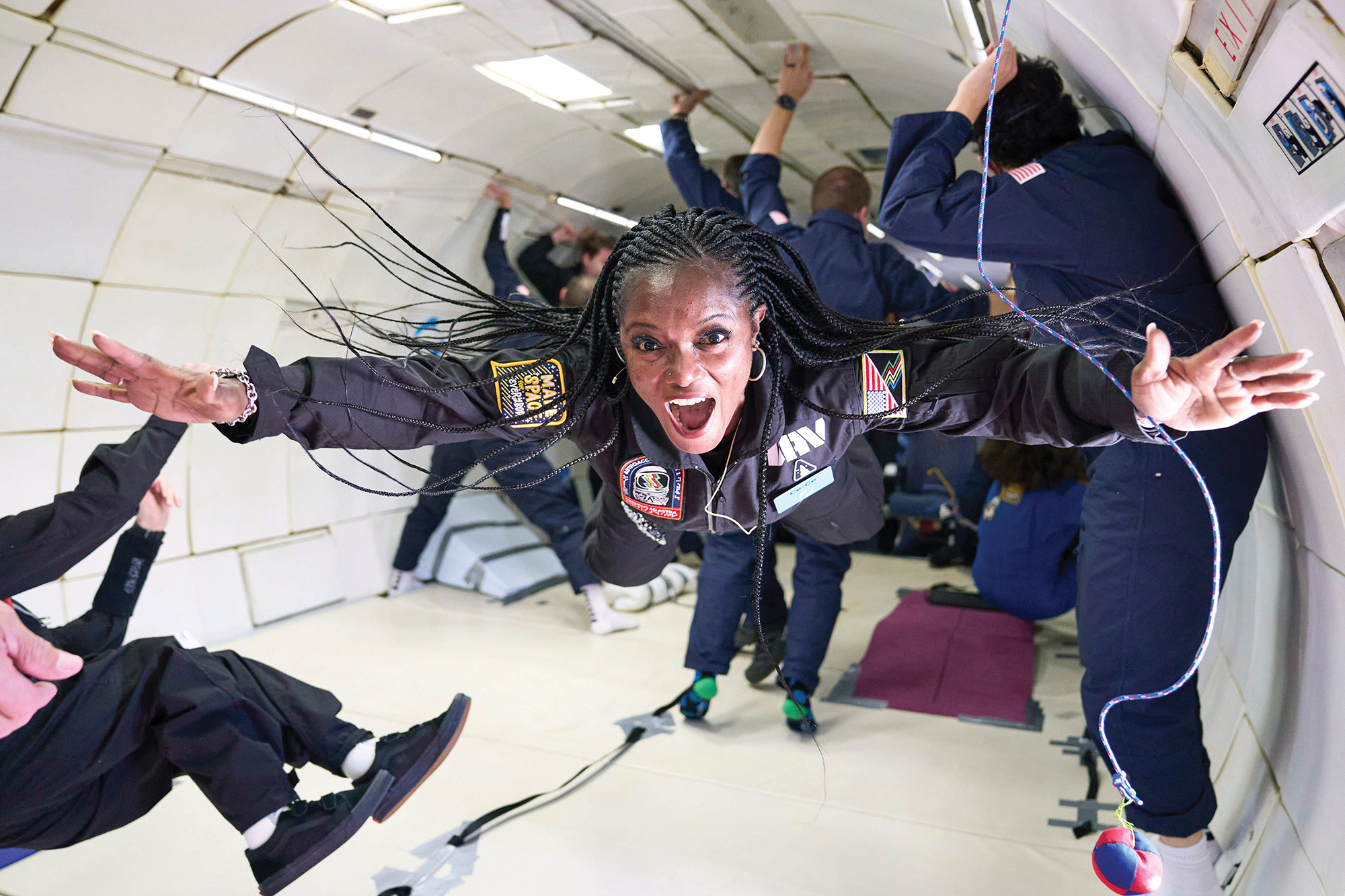
Twelve people with various disabilities floated weightless in simulated space environments—in the name of science and a more accessible final frontier.
Mission: AstroAccess took off from Long Beach Airport last week, carrying the 12 ambassadors—some blind, others with prosthetic limbs and some with hearing and visual impairments. During 15 parabolic maneuvers, various demonstrations took place, some using haptic, lighting and audio cues, to identify challenges and possible solutions for when disabled people venture into space.
“Space should be accessible for all,” co-project lead George Whitesides said in a press conference the day after the mission. “We are on the verge of an incredible moment in human history when … space opens for the benefit of humanity, and we have to take everyone with us—that future has to be inclusive.”
During the Oct. 17 mission, Zero Gravity Corporation’s modified Boeing 727 climbed from 24,000 feet to 32,000 feet at a 45-degree angle, allowing passengers to feel the pull of 1.8 Gs. At the apex of the parabola, pilots took the aircraft into a controlled dive, creating low- and zero-gravity environments. The maneuver was flown 15 times.
The inaugural flight focused on basic operational tasks to demonstrate the abilities of disabled crew members to work effectively in microgravity and investigate solutions for better accessibility. The ambassadors, who were scientists, consultants, veterans, students, athletes, artists and CEOs, are using their experiences to recommend solutions to challenges they faced.
“It’s important that we’re doing this at this time,” said Ambassador Dana Bolles, a Cal State Long Beach alum and science communications expert with NASA, “because we want to be involved in the beginning so we can help shape it.”
“When you think about making places accessible here on Earth,” Bolles added, “it’s a no brainer: It’s a lot cheaper and makes more sense to do it at the beginning rather than retrofit. That is what we want to do in space.”

Bolles, who has no limbs, said she spent most of the parabolas trying to control her movements and stay upright. However, spending her life relegated to a wheelchair on Earth, she said she felt empowered floating weightless through the cabin, despite slight nausea and misgivings.
Apurva Varia, a mission operation director for three spacecraft who is deaf, said signing in zero-gravity made it difficult to control your movements. Through an interpreter, Varia explained how he would have to stop signing to push off the wall, which was disorienting. He did note, however, that he and his interpreter were able to understand each other’s signs while upside down for short periods of time, but he was unsure if it could be sustained for longer periods.
“We did have a lighting system that would help us with our situational awareness,” Varia said. “There are some improvements we need to make for future flights, but this was a great first step.”
AstroAccess investigated challenges related to physical environment accessibility communication as well as safety procedures. A quarter of the United States population has a disability, but people with disabilities make up only 8.4% of the country’s employed scientists and engineers, according to the National Science Foundation.
The goal of AstroAccess’ accessibility improvements is to entice more people with disabilities into STEM fields, according to the mission website. When women entered the space program, it sparked a steady increase of women in STEM—AstroAccess leaders are hoping for a similar trend for disabled people.

“I really wanted to demonstrate that I am able to maneuver and take care of my disability the same way I do on Earth,” Mary Cooper, a below-the-knee amputee and aerospace engineering and computer science student-athlete at Stanford University, said during the press conference.
“I took off my prosthetic leg … and I even let it float around a bit, which is a surreal, euphoric experience, to say the least,” Cooper said. “From there, I was able to put it back on. But I think all of us discovered zero-G is very hard to maneuver in. For me, something that would be really helpful is a foot rail.”
Sina Bahram, a computer scientist and founder of Prime Access Consulting, said he is used to feeling disoriented within a space due to his blindness. While visual cues could be used to assist people with auditory impairments in space, Bahram said audio and vibrational cues as well as textures on surfaces could be used to help the visually impaired.
These solutions could also be helpful for people who are disabled temporarily due to an accident, Bahram added.
Coping mechanisms Bahram and others with disabilities have developed on Earth need to be reimagined for zero-gravity environments, he said. Not only for future suborbital, orbital and trans-planetary missions, but also for space travel tourism.
Space travel for leisure is drawing nearer after successful trips by Richard Branson’s Virgin Galactic and Jeff Bezos’ Blue Origin earlier this year. On Monday, Blue Origin unveiled plans for a space station that could house up to 10 people. The joint venture with Sierra Space would serve as a mixed use business park in space, according to the announcement.

With such fantastical ideas being proposed within the next decade, the work of AstroAccess is more crucial than ever to ensure an inclusive future in space. Disabled U.S. Army veteran Centra “Ce-Ce” Mazyck, a former jumpmaster with the 82nd Airborne Division and single mother, said she applied for the mission for her son, who is now a sophomore in college.
“I do what I do to let him know that just because you have a disability, life does not end,” Mazyck said. “Life truly begins at the end of your comfort zone. We have a long way to go, but we’re making history here.”
